2013 Subaru BRZ Vs 2013 VW Golf GTI

There’s a phenomena in the automotive press right now that could be called “Toybaru vs”. It’s kind of like that TV show Shaq vs, but instead of pitting a retired basketball superstar against various athletes from other fields, it puts the amazing little Scion FR-S or Subaru BRZ against just about anything with four wheels that an enthusiast-driver with $25k to spend might consider a viable option.
I’ve contributed to this head-to-head bonanza on more than one occasion, including FR-S versus Hyundai Genesis 2.0T coupe and BRZ versus Honda Civic Si HFP shootouts. Other notable comparos from around the interwebs include the FR-S vs a used Porsche Boxster and an FR-S vs a Volkswagen GTI. The latter concluded that the GTI was not only easier to drive fast but was actually quicker around the track. Blasphemy!
And not just because pro racing driver Randy Pobst was 2-seconds quicker in a BRZ than a GTI around the very same track as the aforementioned comparo, but also because I’ve spent a lot of time track testing and racing Scion FR-Ss and Subaru BRZs and it seemed utterly preposterous to me to suggest that an understeer-champion like the GTI could ever hold a candle to the sublime little Toybaru in a contest of speed that involves actual changes in direction.
AN INTERESTING PREMISE
To be fair, the premise behind that YouTube video is an interesting one. The presenters readily admitted that the Toybaru is faster around the track than a GTI in the hands of a pro driver, but with more of an Average Joe behind the wheel, they argued that the GTI is quicker because its performance is more accessible and useable.
And to that I respectfully say…poppycock! Or at least that was my mindset coming into this shootout, conducted at the AutoGuide test track. The plan was to have me wring every last drop of performance out of each car to see which is fastest in the hands of an experienced racing driver and then have Road Test Editor Michael Schlee play the role of the Average Joe driver.
Get the Flash Player to see this player.
THE BEST LAID PLANS
After I did a few hot laps in each car and collected the usual in-car data, it was time for a lunch break, after which Mike would post his lap times. But then, quite mysteriously, the BRZ threw a ‘Check Engine’ light during our leisurely drive to the local diner. Once we were back at the track we disconnected the battery in an effort to clear the code, hoping it was just a phantom CEL, but the stubborn little sports coupe refused to fix itself and the light popped back on.
Mike put a call in to Subaru to see what could be done, but we weren’t willing to risk hurting the motor just to stay on script. With the closest Subaru dealership being a couple hours away, we knew we’d have to improvise, and so our Average Joe component got tossed and instead we reverted to our usual “These are the fastest lap times we could squeeze out of each car” approach.
Note: the issue with the BRZ turned out to be related to the variable cam timing system, which was quickly and easily fixed at a dealership with an ECU reflash.
CONSISTENTLY CONSISTENT
One of the things that continue to impress me most about the Subaru BRZ (and it’s Scion sibling) is just how consistently and easily I can find the limit of available adhesion. Part of the reason comes down to the tires, which are relatively low grip and breakaway gradually and predictably, but also because the steering and chassis give you so much feedback that you’d have to be suffering from severe nerve damage not to feel what’s going on underneath you.
As evidence of its consistency, my lap time of 1-minute 26.8-seconds was within 2/10ths of a second of the time I posted a year ago in a different BRZ. It’s also worth noting that my lap times were clustered very tightly over a three lap stint, which also shows that the Toybaru can be driven at the limit for multiple laps without suffering any performance drop off. The brakes continue to be a bit of a weak point, though, with fade starting to rear its ugly head near the end of the session, but an upgrade to a more track-oriented brake pad compound is a cheap and easy fix.
NOT SO UNDERSTEERY AFTER ALL
I haven’t track tested a GTI in quite a while, mostly because this once hardcore hot hatch has progressively gotten softer, heavier and more understeer-prone with each generation. Or so I thought. Clearly things are changing at Volkswagen, because this late model sixth generation GTI, equipped with the Wolfsburg package (which includes very attractive 18-inch wheels, a leather-wrapped steering wheel, and a golf ball shift knob), surprised and impressed me with its willingness to turn.
Rather than tearing its front tires off in the understeer-inducing Turn 1, the GTI held its line remarkably well and would even go into a nice little four-wheel drift if I pitched it in there with a bit of Scandinavian flare. I suspect much of the MkVI GTI’s handling magic stems from its electronic differential, or XDS in VW-speak. Although the car is actually equipped with an open differential, the brakes and stability control system (even when turned “off”) are used to limit inside tire spin, thus serving a similar function as a mechanical limited slip, and in the process helps the Golf stay on the prescribed line.
In fact, the GTI lost virtually no time to the BRZ through the fast and bumpy Turn 1, but the esses (Turns 3, 4 and 5) were a different story. Quick changes in direction will always favor the car with superior balance and transient response, areas the Subaru excels at like few other machines on the planet. As a result, the BRZ pulled a big gap on the nose-heavy VeeDub here, turning a dead-heat on the stopwatch into a 1-second advantage as both cars exited Turn 5.
Compare Specs
| Vehicle | 2013 Volkswagen Golf GTI | Advantage | 2013 Subaru BRZ |
|---|---|---|---|
| Engine | 2.0L I4 Turbo | 2.0L Flat-4 | |
| Horsepower | 200 hp | N/A | 200 hp |
| Torque | 207 lb-ft | GTI | 151 lb-ft |
| Transmission | 6-spd DSG Auto. | 6-speed manual | |
| Weight | 3,160 | BRZ | 2,776 |
| Max Lateral Gs | 1.01g | BRZ | 1.14g |
| Max Braking G’s | 0.78g | BRZ | 0.79g |
| Max Speed | 96.7mph | GTI | 92.4mph |
| Lap Time | 1:28.822 | BRZ | 1:26.882 |
| Fuel Economy | 24/33 | GTI | 22/30 |
| Starting Price | $24,795 | GTI | $26,290 |
| As Tested | $26,990 | GTI | $28,265 |
THE GAP GROWS
The GTI’s superior firepower, in the form of a grossly underrated 2.0L turbocharged 4-banger that makes more like 230 hp (not the factory-rated 200 hp), did help it claw back significant chunks of time between corners, as did its lightning fast 6-speed dual-clutch automatic transmission. And although the Golf showed much more willingness to get down to the apex than I had anticipated, it was still no match for the BRZ in the remaining corners, where the Subaru consistently (there’s that word again) generated higher lateral g-force and cornering speeds, thanks to its significantly lower mass (2,776 lbs vs the GTI’s 3,160 lbs) and vastly superior weight distribution (53/47 compared to the nose-heavy GTI at 61/39).
As a result, by the end of the hottest lap in each car, the agile little Subaru crossed the finish line a full two seconds ahead of the GTI.
Would the result have been any different had our Average Joe been deployed as originally planned? It’s impossible to say without having properly tested this theory, but having coached a lot of enthusiastic young drivers at lapping days, I will concede that a car like the BRZ does require better at-the-limit car control because of its willingness to rotate, and it also requires heel & toe downshifts while the DSG gearbox in the GTI is fast and efficient in the hands of a racer or a retiree.
THE VERDICT
The Volkswagen GTI exceeded my expectations in just about every way, having surprisingly little understeer to go along with its potent turbocharged engine and DSG gearbox combination. It also had a tossability to it that left me wanting to rip a few more laps in it, and I certainly did not expect that from this nose-heavy German. And of course it has a far more luxurious and spacious cabin than the Toybaru, not to mention being a 4-door hatchback makes it significantly more practical.
If it wasn’t for the Focus ST, which blows the VW’s doors off around a race track, I would even say the GTI is my favorite hot hatch on the market thanks to its blend of European quality, practicality, and performance.
SEE ALSO: See Where Each Car Landed on Our Fastest Lap Times List
The Subaru BRZ, on the other hand, further solidified in my mind what a giant wake-up call it is to the rest of the auto industry. A sub $30k car simply shouldn’t be able to transport it’s driver to the same kind of cornering nirvana as world-class sports cars like the Lotus Elise and Porsche Cayman, yet it does. Nor should its steering feel and precision draw similar parallels, but it does.
The only thing holding this glorious little Toyota-Subaru lovechild back from world domination is its undersized brakes and low rent interior, though the Limited model’s cabin is certainly a step in the right direction. The chassis is so good, in fact, that it leaves you wanting more power, but until other automakers respond to the value-performance gauntlet the Toybaru has slapped them across the face with, it’s still in a class all its own.
2013 VW Golf GTI, 2013 Subaru BRZ
LOVE IT
- Potent turbocharged engine and DSG gearbox combo
- Electronic diff neutralizes understeer
- Euro styling, premium interior
- Handling champion of the world! (ok, of the sub $30k category, at least)
- Incredibly precise and communicative steering
- Driver-focused seating position and controls
LEAVE IT
- Nose heavy FWD design
- Soft brake pedal doesn’t inspire confidence
- Brake Fade
- Interior looks and feels low rent
- Needs a sexy exhaust note to match its sheet metal

Some say he's closely related to Bigfoot and that he's a former Canadian Touring Car Champion. All we know is he's the AutoGuide Stig! A thesis defense away from being your intellectual superior he's a professor of vehicle handling dynamics. The part-time touring car and time attack racer is faster (much faster) than your average auto journalist.
More by Dave Pratte
















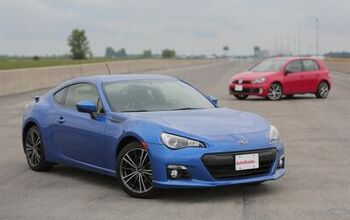
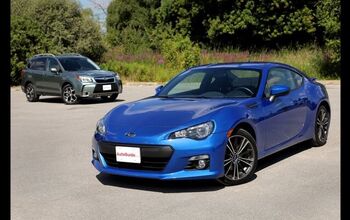


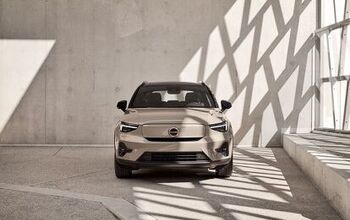


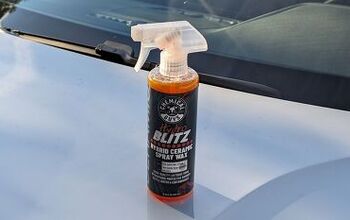
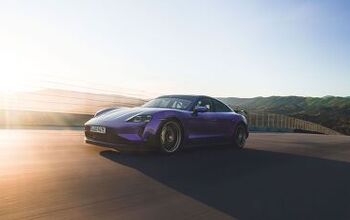
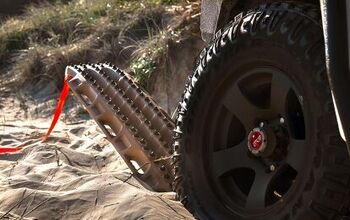

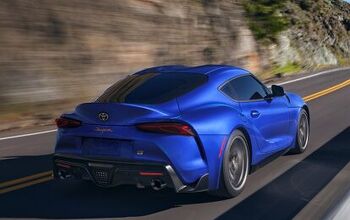
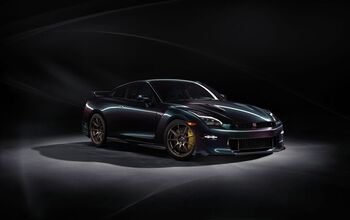

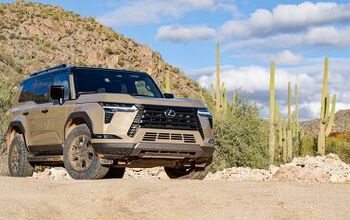
Comments
Join the conversation